
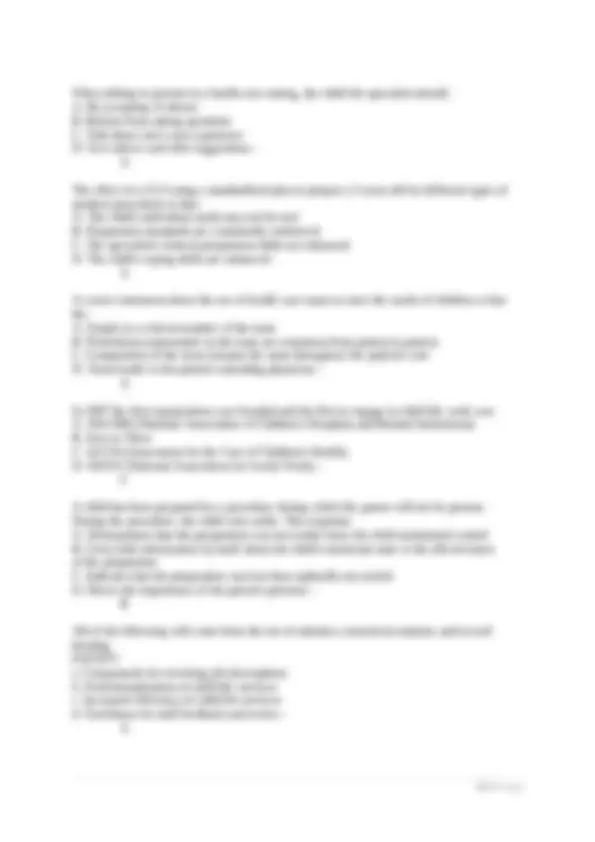
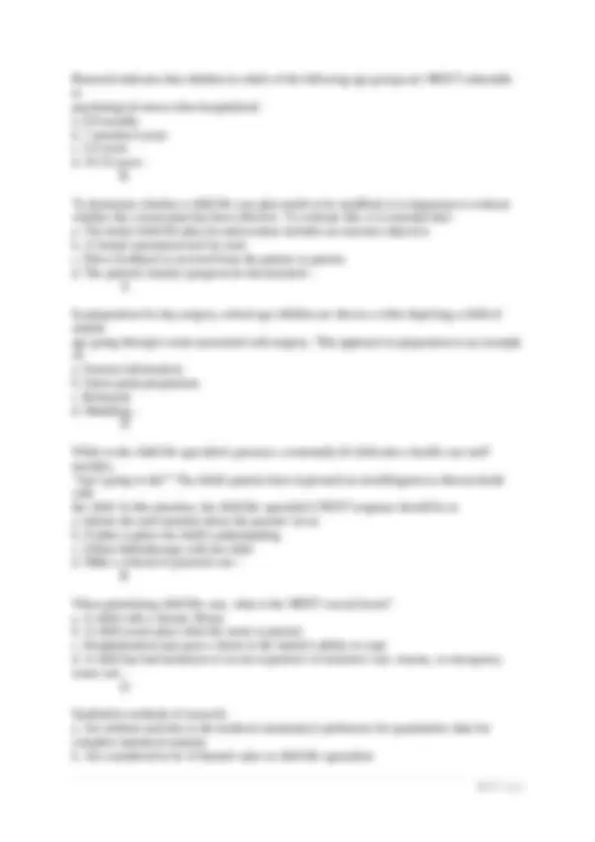
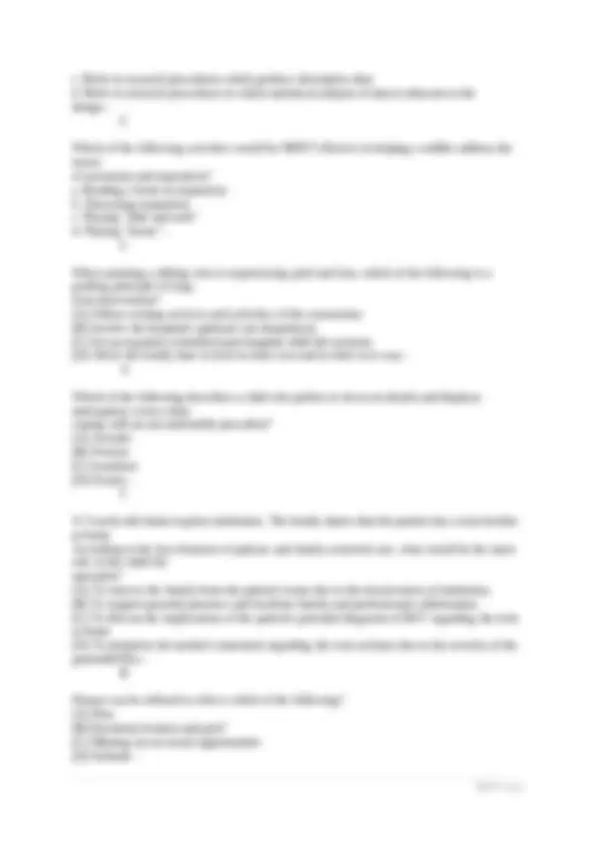
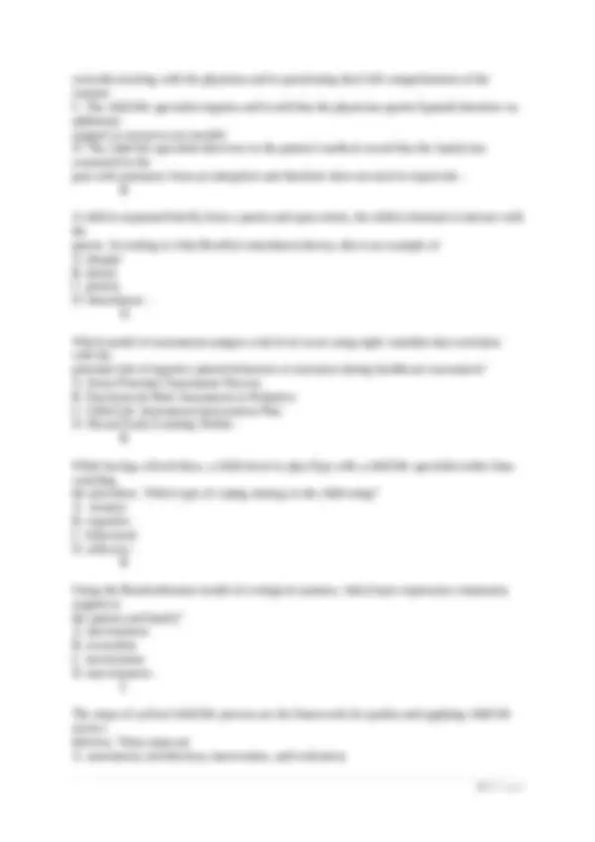
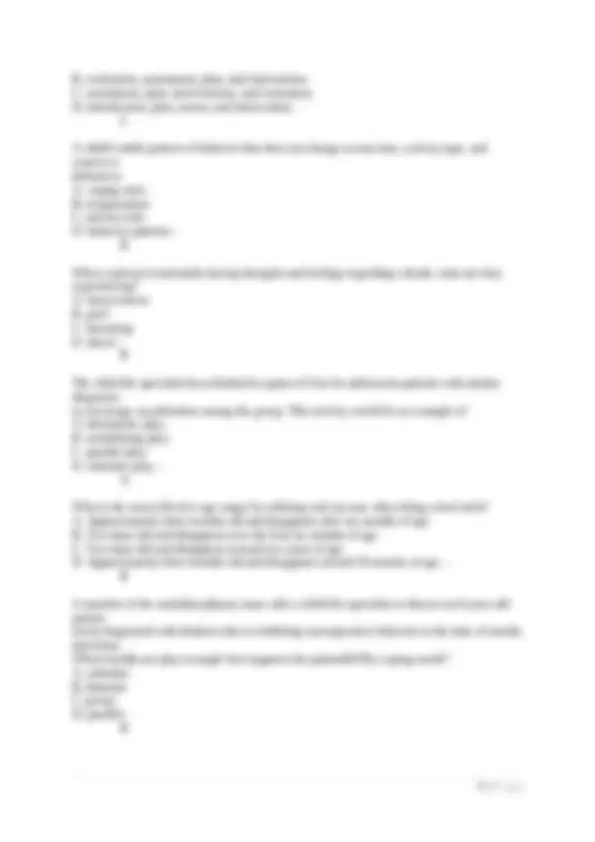
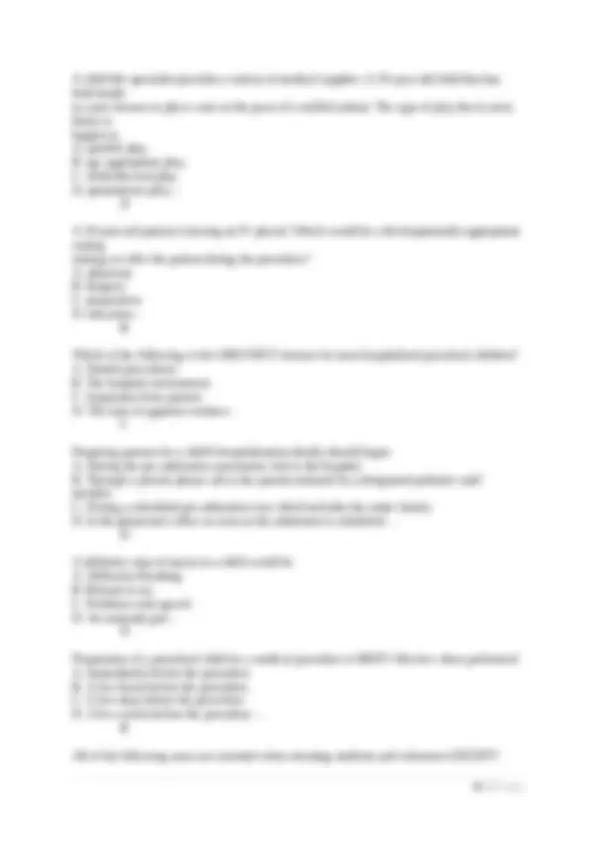
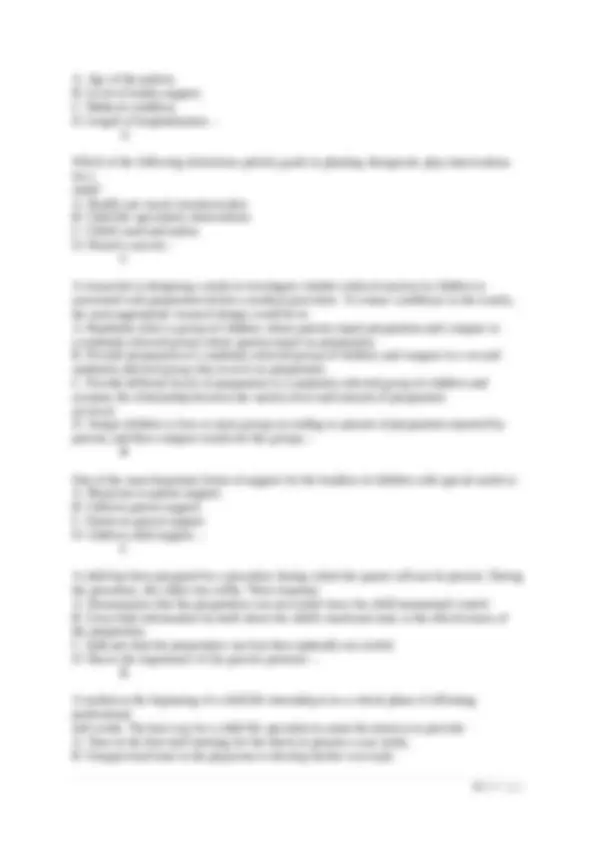
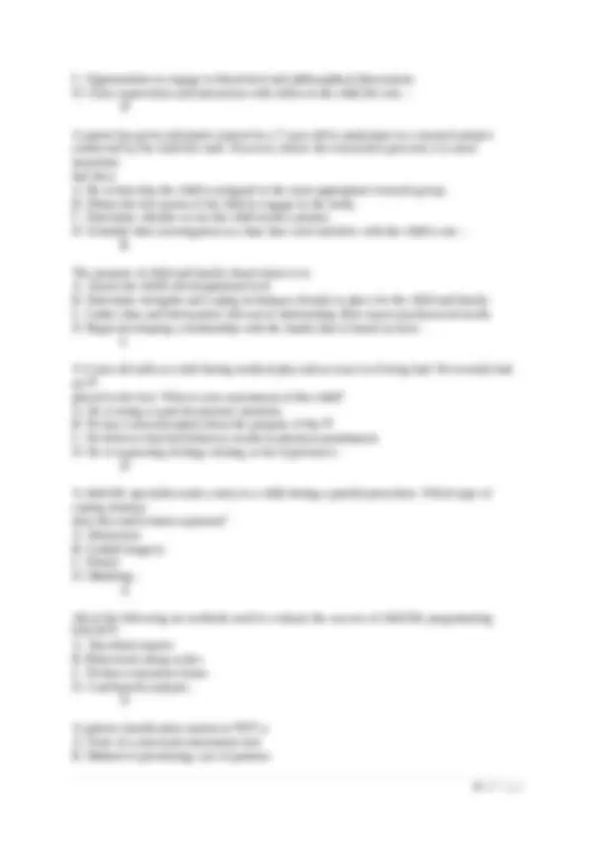
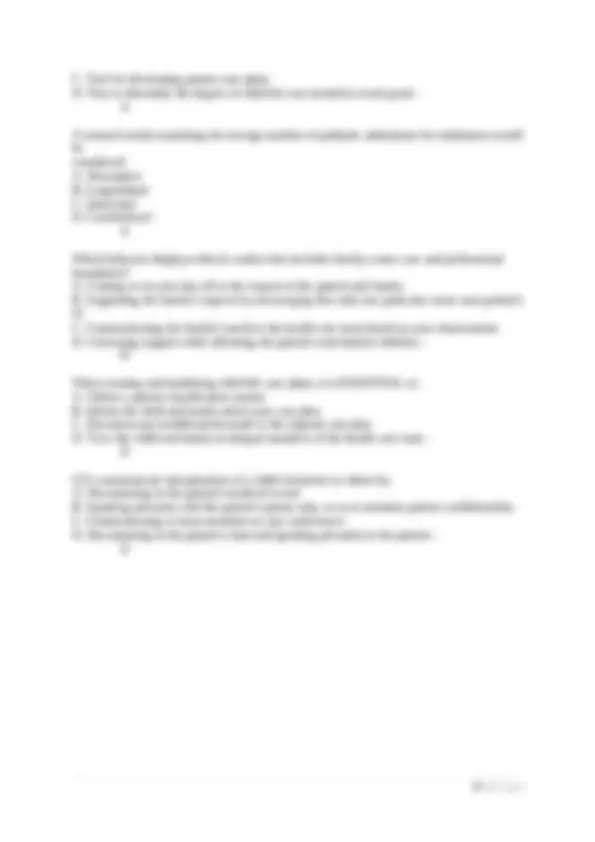


Study with the several resources on Docsity

Earn points by helping other students or get them with a premium plan


Prepare for your exams
Study with the several resources on Docsity

Earn points to download
Earn points by helping other students or get them with a premium plan
Community
Ask the community for help and clear up your study doubts
Discover the best universities in your country according to Docsity users
Free resources
Download our free guides on studying techniques, anxiety management strategies, and thesis advice from Docsity tutors
A collection of exam questions and theories related to the field of child life. It covers various topics, including attachment theory, faith development, stress point care, cross-cultural competency, family systems theory, and play therapy. The document also includes questions and answers related to child life practices, such as preparing children for medical procedures, addressing grief and loss, and understanding child development. This resource can be valuable for students and professionals in the field of child life, providing insights into key concepts and practical applications.
Typology: Exams
1 / 15

This page cannot be seen from the preview
Don't miss anything!










Bowlby's attachment theory - children come into the world biologically pre-programmed to form attachments with others, because this will help them to survive. A child has an innate (i.e. inborn) need to attach to one main attachment figure. This is called monotropy. Fowler's faith development theory - a framework for the spiritual development of people throughout their lives. He argues that the development of people's spiritual awareness runs parallel to other aspects of human development. Fowler Stage 0: Undifferentiated - starts from birth to about the second year of life. A child at this stage learns to trust the goodness or badness of the world based on the way the child is treated by his parents. (Fowler) Stage 1: Intuitive-Projective Faith - is the stage where children begin to use symbols and their imagination. This phase starts where stage 0 ends and continues until about the seventh year of life. (Fowler) Stage 2: Mythic-Literal Faith - is the stage where children begin to use symbols and their imagination. This phase starts where stage 0 ends and continues until about the seventh year of life. (Fowler) Stage 3: Synthetic-Conventional Faith - starts from about age 12 to age eighteen. This stage is characterized by young adults' identification with a religious institution, belief system, or authority. Personal religion or spirituality also takes a growth spurt. (Fowler) Stage 4: Individuative-Reflective Faith - runs from the mid-twenties to late thirties. This stage is characterized by fear and struggle as the person takes responsibility for his or her beliefs and feelings. Fowler Stage 5: Conjunctive Faith - phase is also known as the time of the midlife crisis. A person at this stage recognizes that there are paradoxes and mysteries attached to the transcendent values and norms of faith. As a result, a person goes beyond the traditional beliefs that he or she has inherited from the earlier stages of faith development Fowler Stage 6: Universalizing Faith - Universalizing faith involves making tangible the values of absolute love and justice for humankind. The faith relationship is characterized by total trust in the principle of actively being in relation to others in whom we invest commitment, belief, love, risk, and hope, and in the existence of the future, regardless of what religion or image of faith is involved.
planetree philosophy - We believe that patient's rights are human rights. In our work we promote respect, inclusion and compassion towards all stakeholders in the healthcare enterprise. Planetree's core philosophy of kindness, caring and respect seeks to help realize and sustain human rights everywhere. Stress point care - the process of identifying and planning for the situations with the greatest potential to overwhelm the child's or parent's coping resources. cross cultural competency - awareness that your assumptions about business and communication are not shared by everyone everywhere Family Systems Theory - a theory that views the family as a system of interacting parts whose interactions exhibit consistent patterns and unstated rules behavioral coping strategies - involve changing patterns or behaviors to overcome stress constructive play (kenneth rubin) - play in which children manipulate objects to produce or build something Funtional Play (kenneth rubin) - Using repetitive motions in play such as moving a toy car in circles dramatic play (kenneth rubin) - Children's creation of scenes when they play "pretend" Cultural Sensitivity - being aware that cultural differences exist and have an effect on values, learning, and behavior. grief - "the thoughts and feelings that are experienced when someone they love dies" Child life staff provide volunteer orientation and training on-site to ensure volunteers are aware of the location of essential supplies, infection control policies, and - tips for approaching children and parents If a child is able to engage in a discussion about their religious and/or spiritual beliefs and begin to have a personal relationship with his or her God, we would say that they are in which stage of spiritual development according to James Fowler? - mythical-literal A two-year-old child was recently left alone and appears withdrawn and depressed. According to John Bowlby, this child is in which stage of separation? - despair
Research indicates that children in which of the following age groups are MOST vulnerable to psychological stress when hospitalized. a. 0-6 months b. 7 months-4 years c. 5-9 years d. 10-14 years - B To determine whether a child life care plan needs to be modified, it is important to evaluate whether the current plan has been effective. To evaluate this, it is essential that: a. The initial child life plan for intervention includes an outcome objective b. A formal assessment tool be used c. Direct feedback is received from the patient or parents d. The patient's family's progress be documented - A In preparation for day surgery, school age children are shown a video depicting a child of similar age going through events associated with surgery. This approach to preparation is an example of: a. Sensory information b. Stress-point preparation c. Rehearsal d. Modeling - D While in the child life specialist's presence a terminally ill child asks a health care staff member, "Am I going to die?" The child's parents have expressed an unwillingness to discuss death with the child. In this situation, the child life specialist's NEXT response should be to: a. Inform the staff member about the parents' views b. Further explore the child's understanding c. Utilize bibliotherapy with the child d. Make a referral to pastoral care - B When prioritizing child life care, what is the MOST crucial factor? a. A child with a chronic illness b. A child ceases play when the nurse is present c. Hospitalization may pose a threat to the family's ability to cope d. A child has had imminent or recent experience of intensive care, trauma, or emergency room care - D Qualitative methods of research: a. Are seldom used due to the medical community's preference for quantitative data for complete statistical analysis b. Are considered to be of limited value to child life specialists
c. Refer to research procedures which produce descriptive date d. Refer to research procedures in which statistical analysis of data is inherent in the design - C Which of the following activities would be MOST effective in helping a toddler address the issues of autonomy and separation? a. Reading a book on separation b. Discussing separation c. Playing "hide and seek" d. Playing "house" - C When assisting a sibling who is experiencing grief and loss, which of the following is a guiding principle of long- term intervention? (A) Utilize existing services and activities of the community (B) Involve the hospital's spiritual care department (C) Set up regularly scheduled post-hospital child life sessions (D) Allow the family time to heal on their own and in their own way - A Which of the following describes a child who prefers to focus on details and displays anticipatory worry when coping with an uncomfortable procedure? (A) Avoider (B) Worrier (C) Sensitizer (D) Fixater - C A 5-week-old infant requires intubation. The family shares that the patient has a twin brother at home. According to the key elements of patient- and family-centered care, what would be the main role of the child life specialist? (A) To remove the family from the patient's room due to the invasiveness of intubation (B) To support parental presence and facilitate family and professional collaboration (C) To discuss the implications of the patient's potential diagnosis of RSV regarding the twin at home (D) To minimize the mother's statement regarding the twin at home due to the severity of the patient's - B Humor can be utilized to relieve which of the following? (A) Pain (B) Emotional tension and grief (C) Missing out on social opportunities (D) Solitude -
since these behaviors: A. May change under the stress of hospitalization B. Seldom provide reliable information about individuals C. Are likely to be interpreted to subjectivity D. May vary greatly among different cultural groups - D In the midst of healthcare play, after using an anesthesia mask, a 6 y/o makes a cloth doll sit up and cry out "you are hurting me" which of the following is an example of a reflective statement that could be made by the CLS? a. "you shouldn't be worried about waking up and being in pain" b. "you're worried about waking up and being in a lot of pain" c. "is that baby you? You will sleep the whole time during surgery." d. "That is not the way surgery will be for you, so you don't have to worry" - B Which of the following best describes a child who has had repeated experiences of ineffective coping? a. Anticipatory grief b. Anticipatory anxiety c. Learned helplessness d. Oppositional defiance - C While considering when to prepare a 3-year-old for an upcoming procedure, which of the following is accurate? a. Timing for preparation for the procedure is irrelevant b. The timetable for preparation should vary with the maturity of the child c. The child should be prepared within one hour of the procedure d. The child must be prepared within 72 hours of the procedure - B In determining the child life staff to patient ration, which of the following elements should be given consideration? a. Budget parameters b. Staff preferences c. Seasonal disease outbreaks d. Extent of immobility or isolation - D A physician enters a room alone to obtain informed consent for an upcoming procedure from a family who, in handoff, has been reported to understand English but is primarily Spanish speaking. What should the child life specialist do next? A. The child life specialist speaks to the physician afterwards questioning the family's comprehension and is satisfied when told, "they're fine with it". B. The child life specialist contacts interpretation services, in advocacy, to alert them that the family is
currently meeting with the physician and is questioning their full comprehension of the consent. C. The child life specialist inquires and is told that the physician speaks Spanish therefore no additional support or resources are needed. D. The child life specialist discovers in the patient's medical record that the family has consented in the past with assistance from an interpreter and therefore does not need to repeat the - B A child is separated briefly from a parent and upon return, the child is hesitant to interact with the parent. According to John Bowlby's attachment theory, this is an example of A. despair B. denial. C. protest. D. detachment. - D Which model of assessment assigns a risk level score using eight variables that correlates with the potential risk of negative patient behaviors or outcomes during healthcare encounters? A. Stress Potential Assessment Process B. Psychosocial Risk Assessment in Pediatrics C. Child Life Assessment Intervention Plan D. Hawaii Early Learning Profile - B While having a blood draw, a child elects to play iSpy with a child life specialist rather than watching the procedure. Which type of coping strategy is the child using? A. sensory B. cognitive C. behavioral D. reflexive - B Using the Bronfenbrenner model of ecological systems, which layer represents community support to the patient and family? A. microsystem B. exosystem C. mesosystem D. macrosystem - C The steps of cyclical child life process are the framework for quality and applying child life service delivery. These steps are A. assessment, introduction, intervention, and evaluation.
A child life specialist provides a variety of medical supplies. A 10-year-old child that has both hands in casts chooses to place casts on the paws of a stuffed animal. The type of play that is most likely to happen is A. parallel play. B. age appropriate play. C. child-directed play. D, spontaneous play. - D A 10-year-old patient is having an IV placed. Which would be a developmentally appropriate coping strategy to offer the patient during the procedure? A. playroom B. imagery C. preparation D. education - B Which of the following is the GREATEST stressor for most hospitalized preschool children? A. Painful procedures B. The hospital environment C. Separation from parents D. The lack of apparent routines - C Preparing parents for a child's hospitalization ideally should begin: A. During the pre-admission assessment visit to the hospital. B. Through a private phone call to the parents initiated by a designated pediatric staff member. C. During a scheduled pre-admission tour which includes the entire family. D. In the physician's office as soon as the admission is scheduled. - D A definitive sign of ataxia in a child would be: A. Difficulty breathing B. Refusal to eat C. Problems with speech D. An unsteady gait - D Preparation of a preschool child for a medical procedure is MOST effective when performed: A. Immediately before the procedure. B. A few hours before the procedure. C. A few days before the procedure. D. A few weeks before the procedure. - B All of the following areas are essential when orienting students and volunteers EXCEPT:
A. Summarizing the philosophy and goals of the program. B. Presenting needs and roles of the child and family during the hospital stay. C. Discussing the disadvantages of getting attached to the patient emotionally. D. Explaining children's developmental concepts of grief and death. - D Which of the following will BEST facilitate coping in a preschool child who is intubated and in an intensive care unit? A. Regular multidisciplinary teaching rounds B. Opportunities for dramatic play C. Practices that increase environmental predictability D. Visitations for volunteers and peers - C All of the following are principles for the Code of Ethical Responsibility for Child Life Council Members EXCEPT: A. Recognizing when personal needs are interfering with professional duties. B. Demonstrating respect for all healthcare professionals. C. Sharing patient information with hospital staff on the unit. D. Making referrals when a service needed is beyond the child life professional's qualification. - B Which of the following does NOT demonstrate a child life specialist's commitment to collaboration? A. Advocacy efforts B. Projects to further the mission of the health care facility C. Participation in committee work D. Distribution of goals for patient care to other team members - D Of the following, which is the MOST appropriate way for a schoolteacher to provide support at home or in the hospital for a child who is ill? A. Maintain contact and support by various methods. B. Make certain all school work is collected and sent to the child. C. Reduce academic expectations of the child. D. Ensure that the class is knowledgeable about the child's illness. - A Observation of children engaged in health care play gives accurate information about all the following EXCEPT: A. Coping effectiveness. B. High levels of anxiety related to health care events. C. Understanding of health care procedures. D. Developmental status. - D
A. Age of the patient. B. Level of family support. C. Medical condition. D. Length of hospitalization. - A Which of the following determines priority goals in planning therapeutic play interventions for a child? A. Health care team's treatment plan B. Child life specialist's observations C. Child's need and milieu D. Parent's concern - C A researcher is designing a study to investigate whether reduced anxiety in children is associated with preparation before a medical procedure. To ensure confidence in the results, the most appropriate research design would be to: A. Randomly select a group of children whose parents report preparation and compare to a randomly selected group whose parents report no preparation. B. Provide preparation to a randomly selected group of children and compare to a second randomly selected group who receive no preparation. C. Provide different levels of preparation to a randomly selected group of children and examine the relationship between the anxiety level and amount of preparation received. D. Assign children to four or more groups according to amount of preparation reported by parents, and then compare results for the groups. - B One of the most important forms of support for the families of children with special needs is: A. Physician-to-parent support. B. Child-to-parent support. C. Parent-to-parent support. D. Child-to-child support. - C A child has been prepared for a procedure during which the parent will not be present. During the procedure, the child cries softly. Their response: A. Demonstrates that the preparation was successful since the child maintained control. B. Gives little information by itself about the child's emotional state or the effectiveness of the preparation. C. Indicates that the preparation was less than optimally successful. D. Shows the importance of the parent's presence. - B A student at the beginning of a child life internship is in a critical phase of affirming professional self-worth. The best way for a child life specialist to assist the intern is to provide: A. Time in the first staff meeting for the intern to present a case study. B. Unsupervised time in the playroom to develop his/her own style.
C. Opportunities to engage in theoretical and philosophical discussions. D. Close supervision and interaction with others in the child life role. - D A parent has given informed consent for a 7-year-old to participate in a research project conducted by the child life staff. However, before the researchers proceed, it is most important that they: A. Be certain that the child is assigned to the most appropriate research group. B. Obtain the full assent of the child to engage in the study. C. Determine whether or not the child needs a protest. D. Schedule their investigation at a time that won't interfere with the child's care. - B The purpose of child and family observation is to: A. Assess the child's developmental level B. Determine strengths and coping techniques already in place for the child and family C. Gather data and information relevant to determining their unmet psychosocial needs D. Begin developing a relationship with the family that is based on trust - C A 4 year old yells at a doll during medical play and accuses it of being bad. He recently had an IV placed in his foot. What is your assessment of this child? A. He is trying to gain his parents' attention B. He has a misconception about the purpose of the IV C. He believes that bad behavior results in physical punishment D. He is expressing feelings relating to his experiences - D A child life specialist reads a story to a child during a painful procedure. Which type of coping strategy does this intervention represent? A. Distraction B. Guided imagery C. Denial D. Modeling - A All of the following are methods used to evaluate the success of child life programming EXCEPT: A. Anecdotal reports B. Behavioral rating scales C. Written evaluation forms D. Cost/benefit analysis - D A patient classification system is NOT a: A. Form of a structural assessment tool B. Method of prioritizing care of patients